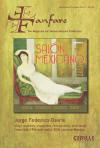Texte paru dans: / Appeared in:

Fanfare Magazine: 36:1(09-10/2012)
Pour
s'abonner / Subscription information
Les abonnés à Fanfare Magazine ont accès aux archives du
magazine sur internet.
Subscribers to Fanfare Magazine have access to the archives of the magazine
on the net.
Zig-Zag Territoires
ZZT110501

Code-barres / Barcode:
3760009292482
Consultez toutes les évaluations recensées pour ce cd
~~~~ Reach all the evaluations located for this CD
Make no mistake about it, the same presumptive funeral Mass for Anne of Brittany is heard on both of these discs.* The work on the second disc was not composed jointly by two men; it is a question of identifying the composer as one or the other of two contemporaries at the royal courts. Anne, the daughter and heiress of Francis II, duke of Brittany, was a crucial figure in her time because the fate of Brittany as an independent duchy was at stake. Living from 1477 to 1514, she succeeded her father in 1488 and married first Charles VIII of France in 1491 (when she was not quite 15 years old), then (months after his death) his older cousin and successor Louis XII in 1499. Brittany finally became part of the kingdom of France only in 1547, when Henry II inherited Brittany from his mother (Anne’s daughter) and France from his father, Louis’s successor. Thus ended centuries of struggle for independence first from England and then from France.
The last Duchess of Brittany was much beloved, continuing to govern her duchy during her marriages. The musical chapel at her court was directed by Anthonius Divitis, who had earlier served Philip the Handsome in Burgundy and Spain. After the death of Anne, he joined the king’s chapel and served until the latter’s death. Antoine de Févin directed the king’s own chapel until he died in 1512. Anne’s funeral rites extended over 40 days as the procession made its way from Blois to Paris and interment at Saint-Denis. Requiem Masses were celebrated several times a day during this time, but the music sung is not mentioned in the detailed chronicle of the event, described in Raisin Dadre’s excellent notes. He and Pérès agree that the Mass recorded here was most likely used for the occasion; Pérès states that five sources of the work exist, two anonymous, two credited to Févin, and one to Divitis. The last source, the Occo Codex, now available in facsimile, is the one both directors used for their recordings. Another Requiem was composed by Prioris, the director of Louis of Orléans’s chapel who continued to serve him after he became king; this Denis Prieur (or Dionysius Prioris) has until recently been identified as “Johannes Prioris,” a false attribution in a single later source. This attribution has been attached even to the modern publication of the composer’s complete works. (His Requiem has been recorded on Accent and Eufoda, still using the false attribution.) Lack of court documentation for Louis’s reign leaves us no indication of the year Févin succeeded Prioris at the court chapel.
The two performances offer a study in contrasts. Raisin Dadre uses instruments with his five singers, and he adds additional pieces to the program, including two unaccompanied laments for Anne, Fiere attropos by Pierre Moulu and the more famous Quis dabit oculis nostris by Costanzo Festa, much imitated by later composers. I have Festa’s lament recorded by Nikolaus Harnoncourt, Konrad Ruhland, John McCarthy, David Munrow, Bernhard Klebel, René Clemencic, Paul van Nevel, Manfred Cordes, and David Skinner, and there are other versions. He also supplies Breton laments from the folk tradition and some instrumental laments. Pérès and his unaccompanied singers keep within the structure of the Mass, adding the epistle, gospel, and preface, concluding with an anonymous motet. It may be remembered that Pérès earlier recorded the Sanctus and Communio of this work to supply missing movements of Ockeghem’s Requiem, but then he used boys for the top line, while now his ensemble (at least this once) is made up of 10 adult mixed voices. Oddly, the two recordings were made less than a month apart for two labels that both belong to the Outhere group. Raisin Dadre has 22 tracks, while Pérès has 13, but because of tracking differences 13 of Raisin Dadre’s tracks devoted to the Requiem are equivalent in content to nine of Pérès’s.
Pérès takes the two movements repeated from his Ockeghem disc much slower this time, the Sanctus nearly twice as slow, now matching Raisin Dadre’s tempos each time, not that he can be faulted for changing his approach 18 years later. Raisin Dadre’s version differs not only in the use of instruments but in the period pronunciation that he adopts. On the other hand, Pérès extends the Kyrie to twice the length of Raisin Dadre’s version, not just by singing triple rather than double invocations (quadruple if you count a recto tono invocation at the beginning of each group) but by slowing the tempo as well. Raisin Dadre’s Breton soloist has a surprise or two. His final selection is titled Stabat Mater, but he sings a Breton paraphrase of that sequence to the tune of the Palm Sunday antiphon, Pueri Hebraeorum.
I find it hard to choose one of these discs over the other. Raisin Dadre’s use of instruments is inappropriate in this situation and his program is overly diffuse, but Pérès’s slow tempos and his growly cantors (especially the one in the introit) nearly disable his well-organized Mass program. If you want one or the other, I would suggest Raisin Dadre, but I look forward to another attempt to bring this music to disc.
*
The CD referred to is "Divitis/Févin" - Requiem - dir. Marcel Perès,
Ensemble Organum, AEON AECD 1216
Fermer la fenêtre/Close window
Cliquez l'un ou l'autre
bouton pour découvrir bien d'autres critiques de CD
Click either button for many other reviews


